Phone Texting: (727) 834-0438
2803 Troy Road
Springfield Ohio 45504
I'll start out by commenting on the 6 strings of 48volt solar arrays that are sitting beneath the wind generator, because it's fresh on my mind.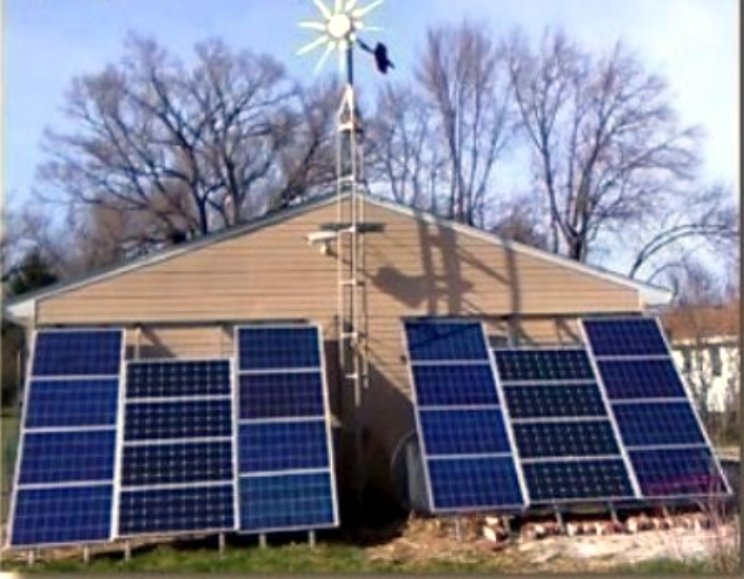 At present all solar panels seen in the image are used for experimental direct-current applications that require no inverter, charge controller, or batteries.
At present all solar panels seen in the image are used for experimental direct-current applications that require no inverter, charge controller, or batteries.
Although tested with a myriad of other appliances, the completely free energy is used to power stoves and other appliances that utilize heating elements (almost exclusively gleaned from broken AC appliances).
The initial experiments were complete failures, usually involving energy to flow freely to lights and fans (tried both dc and ac lights and fans), only to end in failure. What is a huge success is direct current to anything that has an AC heating element (heaters and stoves of all sorts).
Not but a week ago, all 24 solar panels were used concurrently and directly to the water heater, one stove, and as a dump load I also had a charge controller to a battery bank in the loop.
In the configuration where all 24 solar panels are utilized, each device had it's own breaker switch, this allowed for manual redirects of energy when desired (such as wanting to re-direct all available energy to the stove by turning off the other circuits so that all available current rushes off to the resultant stove).
I instantly noticed the difference after diversifying and splitting up the arrays to be separate. At present, half the arrays seen in the image at the top of this page are used exclusively to a charge controller to aid in charging the batteries for night-time use. And although the battery banks are reaping the benefits, I missed having more energy for the cooking and water heater. In fact, whereas there was almost always more hot water than I could possibly ever use when 24 solar panels were redirected to only the hot water tank, now my laundry cannot be washed in scalding water since with half the solar panels I now only am lucky to get two tanks full of hot water by evening.
I think the lesson I've learned most from all the different arrays, voltages (12v initially, then 48v) is that the answer as to how can solar energy be made better, is to have more than you need.
Right now the direct current from the solar panels is split and has been for quite some number of days now. It is split so that 12 solar panels (3 strings of 48v) are directly to a charge controller charging batteries and the other 12 solar panels (3 strings of 48v) are doing the job of keeping two stoves with energy (one is a large unit that distills water, the other for spontaneous cooking of food).
I like the former configuration better.
Having more available "instant" energy is not a problem
(not having enough energy is a potential problem).
The only down-side to the former configuration (all 24 solar panels comprising 6 strings instead of 3 of 48v) is that there is much more wasted energy as a result. For instance, when the water in the water heater is already hot and no longer needing energy, where does that energy go if I'm also not cooking or utilizing the energy as a space heater? The answer is, it's completely wasted energy that will never be used.
On the upside though, I really got spoiled with the former configuration due to its high amount of current. As an example, at 6pm I wanted to cook. The sun goes down about 6pm during this present season and ordinarily I hadn't any care or thought that there would not be enough current to cook with.
With more solar panels, you don't need the sun to be shining, ambient light is adequate. And the great thing about solar panels is that you can always add or change the configurations at the input (and the output) to accomplish the most beneficial configuration for the type of appliance being energized.
So what I've learned is that more solar panels is ALWAYS better when doing Direct Current directly from solar panels to the appliance(s). 48v is clearly a winner over 12v solar arrays for stoves and heaters, and more arrays offering more available energy is tentatively the answer in living with direct current applications.
With too many solar panels you can always turn off, with too few comes gloom.
Before I resume your regularly scheduled programming, I would like to interject a question to the off-grid community.
My question is this:
If we know that when connecting a 6v battery to a 12v battery that the one becomes over-charged and that the other loses some of its energy.
How is it that since my wind generator is turning out voltages that are lower than my battery bank's voltage, that this does not tax my battery bank?
Any argument bringing into the equation of a blocking diode appears to be moot. If the diode receives energy from the wind-side, any energy would be passed to the battery side without some other device regulating that the voltage of the battery be met first (ie. if my battery bank is sitting at 56v and the diode is allowed to pass energy only in one direction even if only producing lower voltages on the wind-side due to low-wind, this seems problematic).
The battery-to-battery example applies here, with only one exception. The wind generator (variable power source or battery) that charges the other battery (battery bank) varies in voltage from 0 to about 60+v depending on wind speed.
In fact, it is a rare occasion when the wind generator spins fast enough to create higher voltages than the battery bank, so it's rare that any real positive voltages are increased at the battery-side.
Thanks
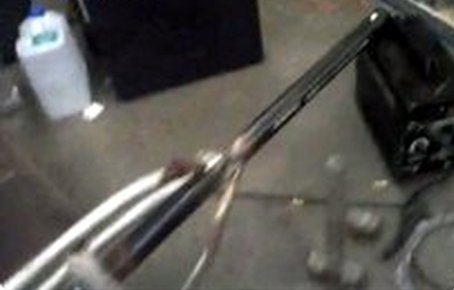
The vertical black pipe needed to be added at the top of the tower to prevent the long blades from hitting anything.
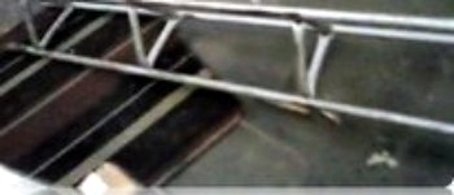

After trying to weld using the wrong type of wire, I out-sourced this project to a man down the road who did the job right.

It's been four years now, and not one solitary problem has sprung up pertaining to any of the stabilizing of the tower.
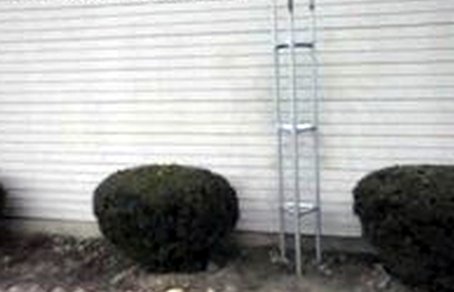
The tower was placed center of the garage peak and allowed for a full swing of the wind generator's long blades.
First Stage install vs. Final Height.
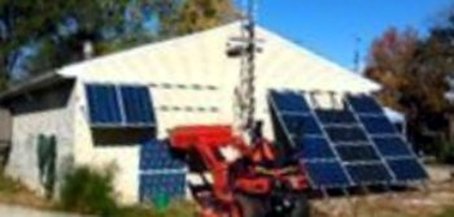
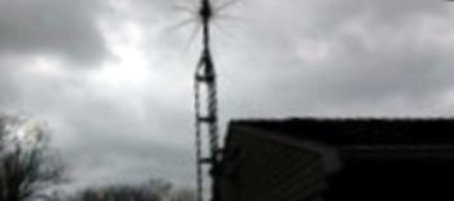
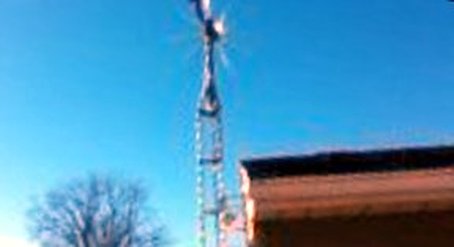
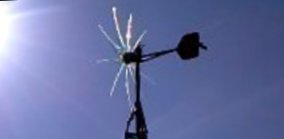
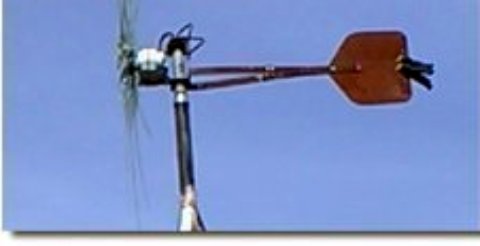
This wind generator is a 48volt and 900w 10-blade wind generator. What makes this unit unique is that it is a 2-wire unit (no rectifier needed as it's built in).
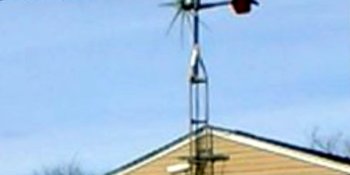
 Early Morning Solar Voltage.
Early Morning Solar Voltage.
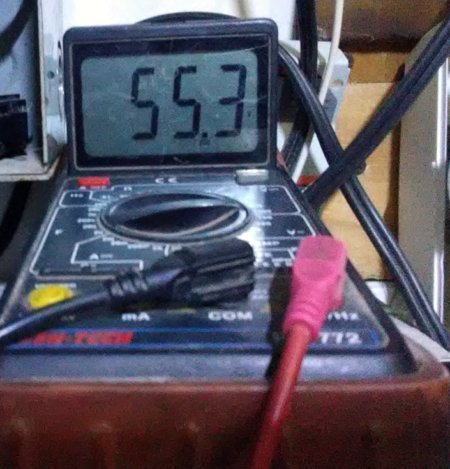 Early Morning Wind Voltage.
Early Morning Wind Voltage.
Comparing Solar energy to Wind
Much wind has arrived in Springfield throughout pretty much the entire night. Ordinarily the wind-generator is not so eventful as are the solar panels when watching the energy flow into the batteries. Last night and this morning are the exception to the rule and provided some excitement as the battery voltage was rising without the need for the sun.
In Kansas and other middle-states that have virtually perpetual wind or periods of constant wind, I imagine a wind generator is the focus of some attention.
Needless to say though, the voltmeter shows data to the hundredths and it was amazing to watch the digits rise 3 volts even under load.
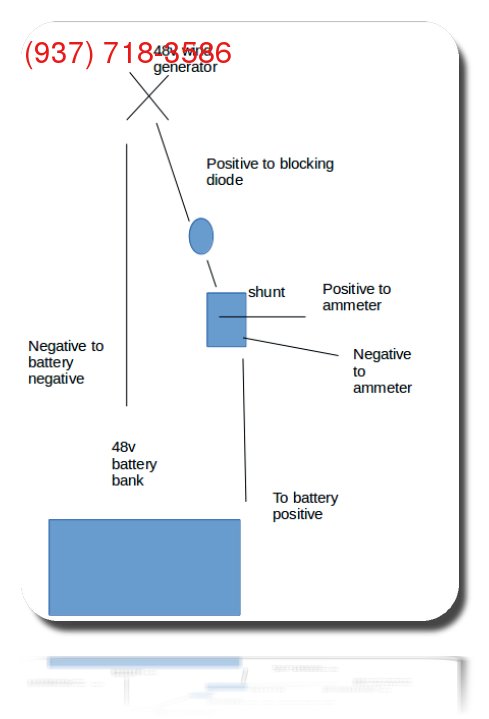
click the image for an Awesome Wind Generator Report
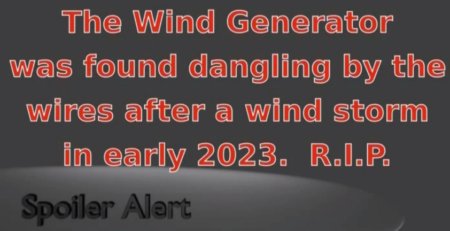
 *If your device does not play the video, try this .mp4 version instead (or just right-click and download the video to your own computer for the smoothest play).
*If your device does not play the video, try this .mp4 version instead (or just right-click and download the video to your own computer for the smoothest play).
click the image for an Not-So-Awesome Wind Generator Report
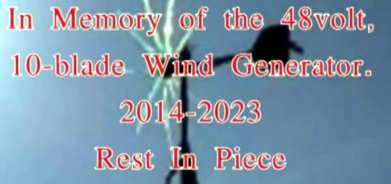
 *If your device does not play the video, try this .mp4 version instead (or just right-click and download the video to your own computer for the smoothest play).
*If your device does not play the video, try this .mp4 version instead (or just right-click and download the video to your own computer for the smoothest play).
Today's Date is Wednesday, 24-Dec-2025 18:01:31 EST
2014-2025 Kenny Hendrick and the Public Diary. All Rights Reserved.
Posted for educative purposes under THE FAIR USE NOTICE: These Videos may contain copyrighted (© ) material the use of which has not always been specifically authorized by the copyright owner. Such material is made available to advance understanding of ecological, political, human rights, economic, democracy, scientific, moral, ethical, and social justice issues, etc. It is believed that this constitutes a 'fair use' of any such copyrighted material as provided for in section 107 of the US Copyright Law. In accordance with Title 17 U.S.C. Section 107, this material is distributed without profit to those who have expressed a prior general interest in receiving similar information for research and educational purposes. For more information go to: http://www.law.cornell.edu/uscode
"Copyright Disclaimer Under Section 107 of the Copyright Act 1976, allowance is made for "fair use" for purposes such as criticism, comment, news reporting, teaching, scholarship, and research. Fair use is a use permitted by copyright statute that might otherwise be infringing. Non-profit, educational or personal use tips the balance in favor of fair use." Disclaimer: 17 Notwithstanding the Provisions of Sections 17 U.S.C. @ 106 and 17 U.S.C. @ 106A, the Fair Use of a Copyrighted work for Educational Purposes- Not For Profit- Non-Commercial. (https://creativecommons.org/licenses/by-sa/3.0/legalcode